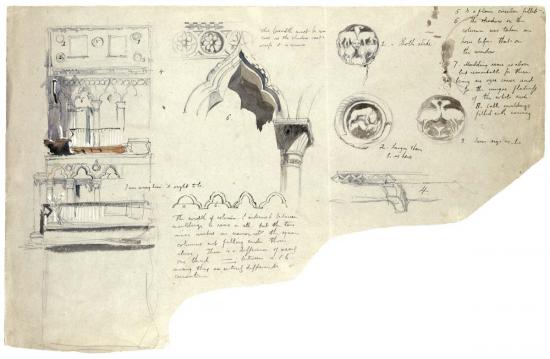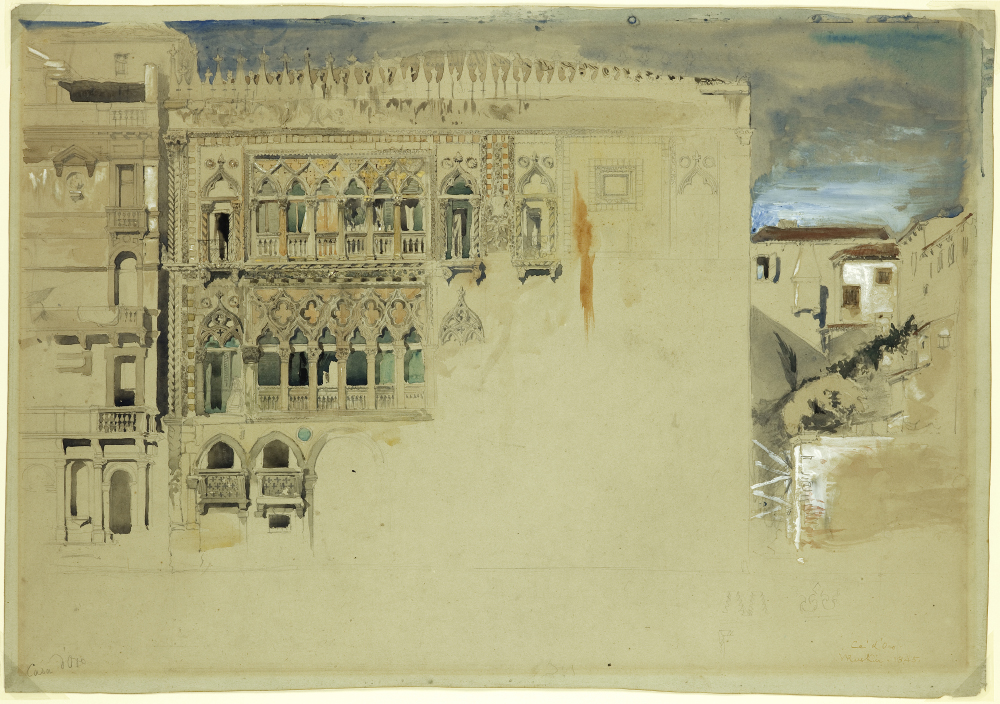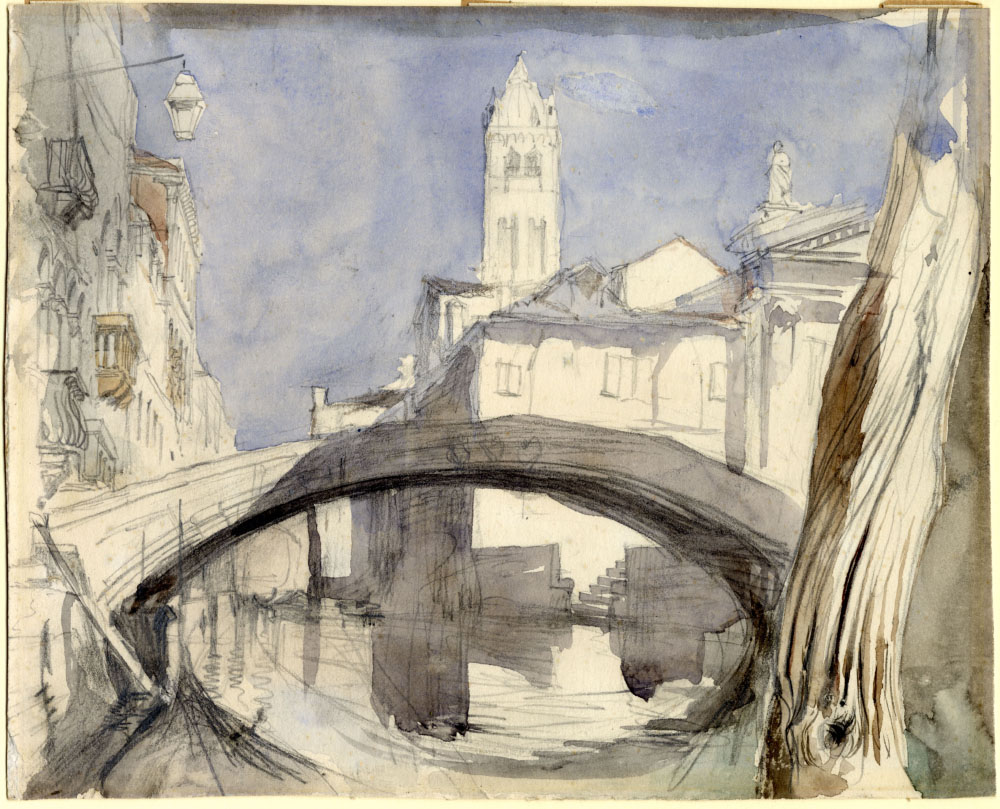1845 | JOHN RUSKIN


 It is no secret that English Victorian intellectual John Ruskin (1819-1900) loved Venice, and the maritime city was the subject of one of his most famous written works, The Stones of Venice. He made over 15 trips to Venice, documenting it in writing as well as in painting, watercolor, sketches, and even early daguerreotype photographs from the late 1840s—all of which is on view at the Palazzo Ducale (Doge’s Palace) in Venice through June 10.
The exhibition, titled John Ruskin: Le pietre di Venezia (John Ruskin: The Stones of Venice), shows a breadth of material that he produced on his many journeys to the city, with a particular focus on his art. The curators call Ruskin “a central figure in the nineteenth-century international art scene, a writer, painter and art critic,” and seek to illustrate how strongly he was tied to Venice and its architecture.
The show features sketchbooks, prints, plaster casts, watercolors, and architectural studies from Ruskin, his influences, and his contemporaries. The objects on view further contextualizes Ruskin’s within the history of Venice, but also within the history of art itself. By displaying the material in the heart of Venice in a building that is featured prominently in the exhibition, it becomes an immersive history lesson from many angles.
Ruskin was a proto-socialist and a religious man who wrote often of the moral and social aspects of aesthetics and craft. Ruskin had a fondness for the Gothic and Byzantine, as well as the Medieval and “anti-classical” Venice that he felt was being erased in favor of the Renaissance, a trend he tied to the moral and spiritual decay of Venetian society:
“[Venice]… is still left for our beholding in the final period of her decline: a ghost upon the sands of the sea, so weak—so quiet,—so bereft of all but her loveliness, that we might well doubt, as we watched her faint reflection in the mirage of the lagoon, which was the City, and which the Shadow.
I would endeavour to trace the lines of this image before it be for ever lost, and to record, as far as I may, the warning which seems to me to be uttered by every one of the fast-gaining waves, that beat, like passing bells, against the Stones of Venice.”
Most notably is the influence of one of the first modern painters, the English Romantic J. M. W. Turner, who like Ruskin was grappling with the rise of Modernism. For Turner, this was a cutting-edge use of abstraction to create effects in painting—which Ruskin also engaged with following Turner’s lead. Both Ruskin’s landscapes and his analytical paintings are included in the exhibition. A selection of manuscripts and sketchbooks for The Stones of Venice provide a glimpse into his ways of working, as well.
Information on tickets to the show and hours of operation can be found here.
SOURCE:
the architect's newspaper
It is no secret that English Victorian intellectual John Ruskin (1819-1900) loved Venice, and the maritime city was the subject of one of his most famous written works, The Stones of Venice. He made over 15 trips to Venice, documenting it in writing as well as in painting, watercolor, sketches, and even early daguerreotype photographs from the late 1840s—all of which is on view at the Palazzo Ducale (Doge’s Palace) in Venice through June 10.
The exhibition, titled John Ruskin: Le pietre di Venezia (John Ruskin: The Stones of Venice), shows a breadth of material that he produced on his many journeys to the city, with a particular focus on his art. The curators call Ruskin “a central figure in the nineteenth-century international art scene, a writer, painter and art critic,” and seek to illustrate how strongly he was tied to Venice and its architecture.
The show features sketchbooks, prints, plaster casts, watercolors, and architectural studies from Ruskin, his influences, and his contemporaries. The objects on view further contextualizes Ruskin’s within the history of Venice, but also within the history of art itself. By displaying the material in the heart of Venice in a building that is featured prominently in the exhibition, it becomes an immersive history lesson from many angles.
Ruskin was a proto-socialist and a religious man who wrote often of the moral and social aspects of aesthetics and craft. Ruskin had a fondness for the Gothic and Byzantine, as well as the Medieval and “anti-classical” Venice that he felt was being erased in favor of the Renaissance, a trend he tied to the moral and spiritual decay of Venetian society:
“[Venice]… is still left for our beholding in the final period of her decline: a ghost upon the sands of the sea, so weak—so quiet,—so bereft of all but her loveliness, that we might well doubt, as we watched her faint reflection in the mirage of the lagoon, which was the City, and which the Shadow.
I would endeavour to trace the lines of this image before it be for ever lost, and to record, as far as I may, the warning which seems to me to be uttered by every one of the fast-gaining waves, that beat, like passing bells, against the Stones of Venice.”
Most notably is the influence of one of the first modern painters, the English Romantic J. M. W. Turner, who like Ruskin was grappling with the rise of Modernism. For Turner, this was a cutting-edge use of abstraction to create effects in painting—which Ruskin also engaged with following Turner’s lead. Both Ruskin’s landscapes and his analytical paintings are included in the exhibition. A selection of manuscripts and sketchbooks for The Stones of Venice provide a glimpse into his ways of working, as well.
Information on tickets to the show and hours of operation can be found here.
SOURCE:
the architect's newspaper
ARTISTS
1992 | OLIVIER TUSCANI
06.11.2024
06.11.2024
2024 | MONTE DI PIETÀ
06.11.2024
06.11.2024
2024 | WHAT THE HECK
06.11.2024
06.11.2024
2022 | AGNESE
22.09.2024
22.09.2024
2022 | ANOUK CHAMBAZ
22.09.2024
22.09.2024
2022 | CAMILLA PINTONATO
22.09.2024
22.09.2024
2022 | CARLO FREDERICO DALL OMO
22.09.2024
22.09.2024
2022 CRISTINA CAPPELLARI
22.09.2024
22.09.2024
2908 | CLAUDE MONET
22.09.2024
22.09.2024
2022 | DAVIDE DI LIBERO
22.09.2024
22.09.2024
2022 | DITA LAMMERSE
22.09.2024
22.09.2024
2022 | FERRUCIO CONSTANTINI
22.09.2024
22.09.2024
2022 | GABRIELE FRISINA
22.09.2024
22.09.2024
2022 | GINEVRA CARBONE
22.09.2024
22.09.2024
2022 | GIUDITTA TRANI
22.09.2024
22.09.2024
2022 | GIUSEPPE DI LIBERO
22.09.2024
22.09.2024
2022 | GREGOIRE GUEX-CROSIER
22.09.2024
22.09.2024
2022 | HADI EL HAGE
22.09.2024
22.09.2024
2022 | IRENE INAMORATI
22.09.2024
22.09.2024
2022 | IRENE SGARRO
22.09.2024
22.09.2024
2022 | JACOPO CALAFATI
22.09.2024
22.09.2024
2022 | JEAN MANUEL TRAYMOND
22.09.2024
22.09.2024
JULIE PELLIZZARI
22.09.2024
22.09.2024
LISA KOSTNER
22.09.2024
22.09.2024
LUISA EUGENI
22.09.2024
22.09.2024
NICOLO CEDENO
22.09.2024
22.09.2024
OMAR PAVANELLO
22.09.2024
22.09.2024
PAOLA MOMENTE
22.09.2024
22.09.2024
PIERRE AUGUSTE RENOIR
22.09.2024
22.09.2024
RICCARDO BANFI
22.09.2024
22.09.2024
SIRA VIVIANI
22.09.2024
22.09.2024
SYLINE
22.09.2024
22.09.2024
SOPHIE WESTERLIND
22.09.2024
22.09.2024
UGO CARMENI | I
22.09.2024
22.09.2024
STEPHANIE UZUMYEMEZOGLU
22.09.2024
22.09.2024
TIZIANO CIAO
22.09.2024
22.09.2024
UGO CARMENI
22.09.2024
22.09.2024
NICOLAS MOUCHERONT
22.09.2024
22.09.2024
2022 | MAN VU | I
15.09.2024
15.09.2024
2021 | YURI ANCARANI
15.09.2024
15.09.2024
2022 | UNIVERSAL MARKET
15.09.2024
15.09.2024
2022 | MAN VU | II
15.09.2024
15.09.2024
2022 | MAN VU | III
15.09.2024
15.09.2024
2022 | MAN VU | IV
15.09.2024
15.09.2024
2022 | MAN VU | V
15.09.2024
15.09.2024
2022 | UNIVERSAL MARKET
15.09.2024
15.09.2024
2022 | VENICE DAILY LIFE
15.09.2024
15.09.2024